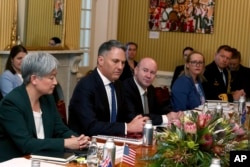Australia will be seeing more U.S. troops, more U.S. planes, more U.S. ships and more U.S weapons as the two allies take what officials describe as a “major step” in strengthening and expanding their military alliance.
The United States and Australia unveiled the agreements to increase the rotational presence of American forces and capabilities, and to help integrate Australia into key U.S. defense production capabilities Saturday, following hours of talks by the top U.S. and Australian defense and diplomatic officials.
“Australia at this moment has no better friend than America," Australian Defense Minister Richard Marles told reporters following the conclusion of the 33rd annual Australia-United States Ministerial Consultations in Brisbane, Australia.
Marles said the agreements include a larger U.S. rotational presence at Australia’s northern military bases, additional visits by U.S. vessels and maritime patrol and reconnaissance aircraft, and “an increased tempo of visits from U.S. nuclear-powered submarines” until Australia is able to acquire its own with U.S. help.
Just as importantly, according to U.S. and Australian officials, the new agreements will pave the way for Australia to join the United States in the production of missiles and ammunition at a time when the war in Ukraine, and Western support, has eroded key stocks.
"We hope to see manufacturing of missiles commenced in Australia in two years' time," Marles said.
The initial focus will be on Australian production of Guided Multiple Launch Rocket Systems, also known as GMLRS. However, U.S. officials said Washington also intends to support Australian production of 155 mm artillery shells, which have been in high demand in Ukraine.
“These initiatives will strengthen our ability to respond to crises in the region while enhancing our interoperability,” U.S. Defense Secretary Lloyd Austin said, describing the efforts as a “major step” for the U.S. and Australian defense industrial base.
'Significant step forward'
Other U.S. officials agreed, suggesting Australia could eventually help with the production and maintenance of other weapons and systems.
“I think what we have seen very clearly is the value across the board on strengthening the defense industrial base, not just of the United States, but of our allies and partners,” a senior U.S. defense official told reporters, speaking on the condition of anonymity. “We see this as a significant step forward.”
Marles and Austin, along with Australian Foreign Minister Penny Wong and U.S. Secretary of State Antony Blinken, also expressed confidence that despite the opposition of some U.S. lawmakers, an agreement to provide Australia with three nuclear-powered submarines will go through.
“This is in both our countries’ interest,” Wong said, speaking alongside the others outside the Queensland Government House in Brisbane.
"Whether it’s the acquisition of the AUKUS submarine capability or all of the other capabilities in which we are engaged … we see this as increasing the capability of our nations across many domains,” she said.
The agreements also include provisions for greater cooperation in space and for investments in Australia’s military infrastructure.
Blinken said such cooperation is critical if the United States and Australia are to be able to push back against China and maintain "a region where countries are free to chart their own path and choose their own partners.”
“We’re doing that in part by engaging China but also as necessary opposing its efforts to disrupt freedom of navigation and overflight in the South and East China seas, to upend the status quo that has preserved peace and stability across the Taiwan Strait, to pressure countries through economic coercion or threats to their citizens,” he said.
Regional cooperation
U.S. officials, speaking on the sidelines of the ministerial, also said the two countries are looking to increase cooperation with other countries in the region. One example is a proposal for trilateral cooperation with Japan for exercises and training on the F-35 stealth fighter in Australia.
They also pointed to the current Talisman Sabre exercise, which this year has seen participation from India, Indonesia, Japan, South Korea and New Zealand, as well as Papua New Guinea, Fiji and Tonga.
The officials also noted other agreements, such as the Defense Cooperation Agreement with Papua New Guinea and the Enhanced Defense Cooperation Agreement with the Philippines.
“It is evolutionary,” said a second senior U.S. defense official, like the first briefing on the condition of anonymity.
“There's a number of mini lateral and multilateral arrangements that are complementary ... each of them is providing, in some ways, overlapping but unique provisions of security,” the official said. “It is, again, a profound trend in the region.”









